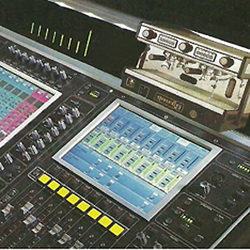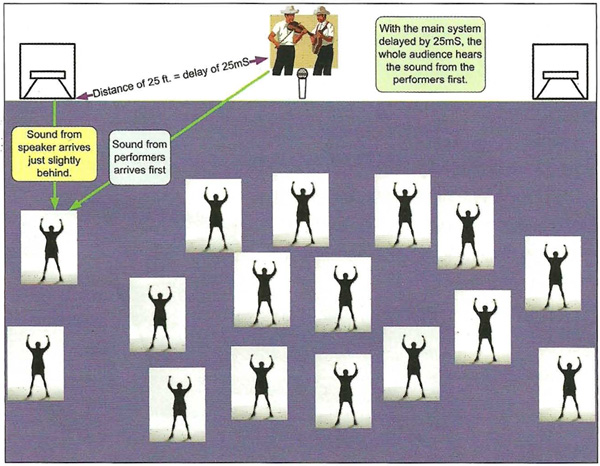
Of course, a center loudspeaker (or cluster) can draw the sound back toward the center regardless of audience position.
But often, this approach isn’t feasible or is cost prohibitive, and it’s often not enough because sound from the loudspeakers is still arriving to a large portion of the audience before it arrives from the person talking.
With a single person, this generally isn’t too bad—but it can be a real problem with a band, with the back portion of the group anywhere from 20 to 40 feet from the loudspeakers, which can result in a delay of up to 40 milliseconds (ms).
An electronic solution is probably needed. Digital delay can be a real friend in these situations, and it’s now relatively now cheap and plentiful.
Digital mixing consoles, for example, often have them already installed on every input and output channel.
Here’s the basic technique: delay the main PA loudspeakers by the amount equivalent to the distance between the loudspeakers and the back of the band, (See Figure 2)
You may also choose to use the drums as a reference, since it’s a good idea to have percussive instruments well aligned to the PA wavefront. The ear is more readily able to identify timing differences with transient sounds, i.e,. from drums. Also, drums produce quite a bit of their own acoustic sound pressure, so the audience will typically hear both the acoustic and the PA version of that sound, which is not necessarily true for most other instruments on stage.

For example, if the drum set is 30 feet behind the main loudspeakers, then delay the feed to the stacks by about 30 ms. This way, as the sound from the drums comes off the stage and into the audience, the sound from the PA will line up with it.
I typically add an additional 5 to 10 ms to that figure, just to ensure that the original sound arrives first. This gives the distinct illusion that the sound is coming from the band rather than the PA.
TO WRAP IT UP
All these methods may not be needed all the time. But since you’ re now aware of them, you can incorporate these ideas as the situation dictates and as the budget allows.
And to some extent, the irony of this is that many people at the gig may not even realize that the band was amplified. Thus, you won’t get any compliments, phone numbers or panties thrown at you like you usually do.
But deep down, you’ll know that you’ve achieved some magic—and that the audience experience was enhanced in a subtle but real way. After all, isn’t it all about the music? OK, maybe not. I’ll leave it up to you to make that choice.
Karl Winkler is the vice president of sales/service at Lectrosonics and has worked in professional audio for more than 20 years.
